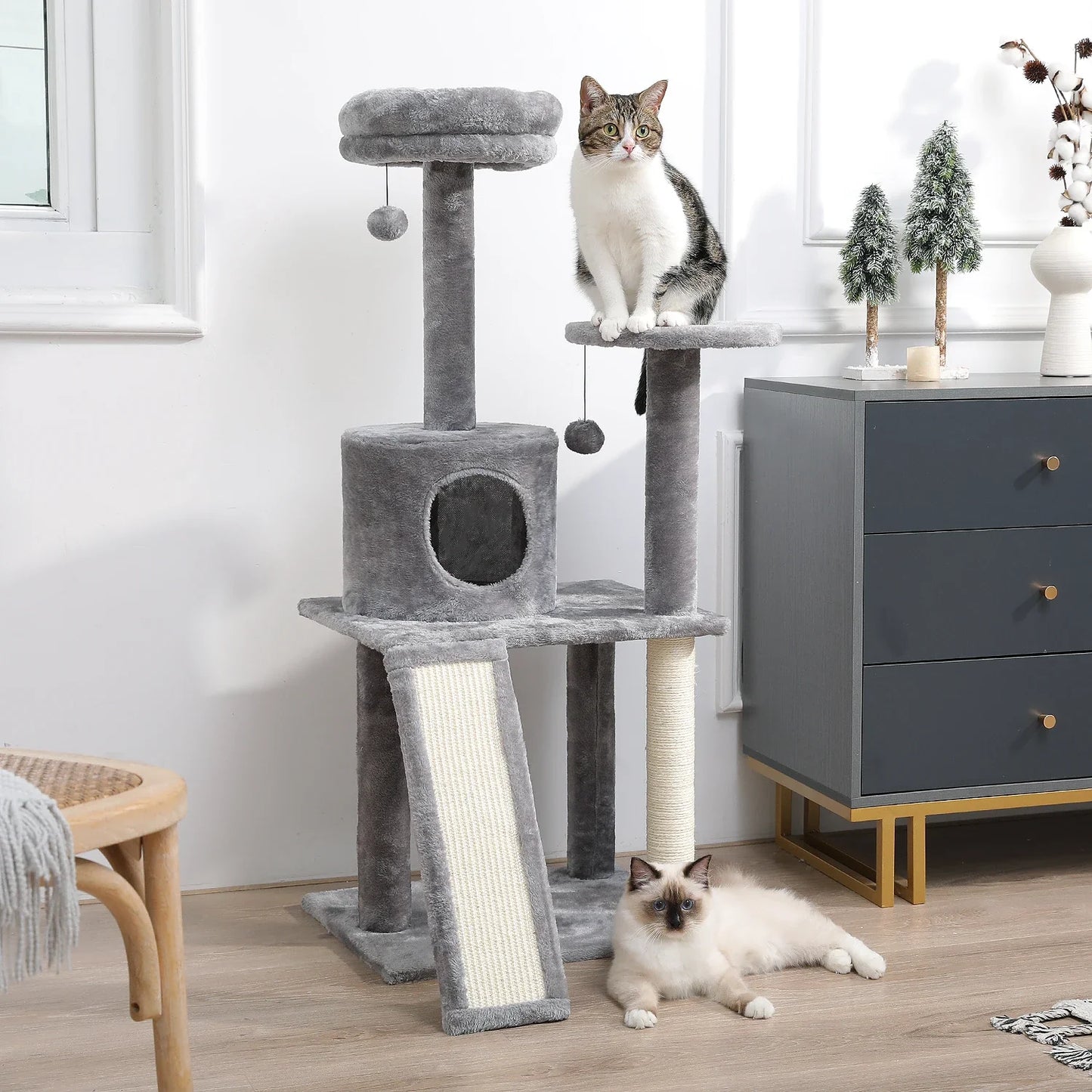Introduction
For cat owners, furniture scratching can be a frustrating behavior. Understanding why cats scratch and providing appropriate alternatives like cat trees can significantly reduce unwanted scratching. This guide delves into the role cat trees play in mitigating furniture scratching and how to effectively use them for this purpose.
Understanding Why Cats Scratch
Scratching is a natural and essential behavior for cats, serving several purposes:
- Marking Territory: Cats have scent glands in their paws, which leave their scent on surfaces they scratch.
- Maintaining Claw Health: Scratching helps remove the outer nail sheaths, revealing sharp new claws.
- Stretching and Exercise: It provides a full-body stretch and strengthens their muscles.
- Stress Relief: Scratching can be a way for cats to relieve stress or excitement.
The Role of Cat Trees in Redirecting Scratching Behavior
1. Appropriate Scratching Surfaces
- Cat trees often incorporate sisal-wrapped posts or carpeted areas, which are ideal surfaces for scratching.
- Offering an appealing alternative can redirect scratching from furniture to the cat tree.
2. Scent Marking and Territory
- By providing a dedicated space for scratching, cat trees allow cats to mark their territory in an appropriate area, reducing their need to mark furniture.
3. Height Advantage
- Cats are attracted to vertical surfaces for scratching. Tall cat trees mimic this preference, making them more appealing than horizontal furniture surfaces.
4. Location Strategy
- Placing cat trees near areas where unwanted scratching occurs can effectively redirect the behavior.
Choosing the Right Cat Tree for Scratching
1. Material Selection
- Look for cat trees with durable scratching surfaces like sisal or tough fabric.
- Avoid materials that closely mimic your furniture upholstery to prevent confusion.
2. Sturdiness and Stability
- A stable cat tree is essential as cats are more likely to use a scratching surface that doesn’t wobble or tip.
3. Variety of Scratching Options
- Cat trees with different scratching angles and heights cater to various scratching preferences.
Introducing the Cat Tree for Scratching
1. Initial Introduction
- Encourage exploration with treats and catnip.
- Gently place your cat near the tree, allowing them to discover the scratching surfaces on their own.
2. Positive Reinforcement
- Praise and reward your cat for using the cat tree for scratching.
- Use toys and playtime near the tree to create positive associations.
3. Consistency and Patience
- It may take time for your cat to transition from furniture to the cat tree. Consistently encourage and reward use of the tree.
Training Tips to Redirect Scratching
1. Discouraging Furniture Scratching
- Use deterrents like double-sided tape or anti-scratch sprays on furniture.
- Redirect your cat to the cat tree whenever they start scratching furniture.
2. Multiple Scratching Options
- Provide multiple scratching posts or pads in different areas of your home.
3. Observation and Adaptation
- Observe your cat's scratching habits to understand their preferences.
- Adjust the placement or type of cat tree and scratching posts based on these observations.
Maintaining the Cat Tree for Continued Use
1. Regular Inspection and Maintenance
- Check for wear and tear, tightening any loose parts.
- Replace worn-out scratching surfaces as needed.
2. Keeping It Clean
- Clean the cat tree regularly to keep it inviting. Remove any loose threads or debris.
Common Challenges and Solutions
1. Lack of Interest
- Experiment with different cat tree locations and styles.
- Enhance the appeal with catnip or hanging toys.
2. Older Habits Die Hard
- For cats accustomed to scratching furniture, a gradual transition with consistent reinforcement is necessary.
3. Multi-Cat Households
- Provide multiple scratching options to cater to different preferences and reduce competition.
Conclusion
Cat trees play a significant role in redirecting scratching behavior away from furniture. By understanding why cats scratch and providing appealing alternatives, you can protect your furniture while satisfying your cat’s natural instincts. The key to success lies in choosing the right cat tree, positive reinforcement, and patience. Remember, every cat is unique, and finding the right solution may require some trial and error. Discover Australia's most affordable range of premium cat trees and towers at cattreehaven.com.au where we bring joy to your feline friends with Australia's best cat trees and towers!
FAQs
Q: How long does it take for a cat to start using a cat tree for scratching?
A: This can vary. Some cats may take to it immediately, while others might need a few weeks or longer. Consistency and positive reinforcement are crucial.
Q: Can declawed cats benefit from a cat tree?
A: Yes, declawed cats still enjoy climbing and lounging on cat trees, although they won’t use it for scratching.
Q: Should I remove old scratching posts when introducing a new cat tree?
A: Not immediately. Allow your cat to get accustomed to the new tree first before phasing out the old scratching posts.
In summary, a cat tree can be an effective tool in managing and redirecting furniture scratching behavior in cats. It fulfills their scratching instincts in a safe and appropriate manner while providing a space for exercise and relaxation. With the right approach and understanding of your cat's needs, a cat tree can enhance both your cat's well-being and your living space harmony.



